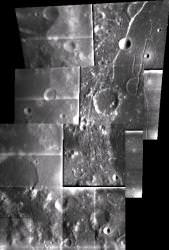ESA’s SMART-1 spacecraft was purposely crashed into the Moon on September 3, 2006. But before it died, it analyzed the Moon in incredible detail. One of the key questions it’s attempting to help scientists answer: how were surface features formed? By putting together data from both SMART-1 and NASA’s Clementine spacecraft, scientists have detailed views of some of the fine details that will help answer these questions.
Most of the Moon’s surface features – all those big craters – were created approximately 350-750 million years after the formation of the Moon, during a period called the Lunar Late Heavy Bombardment period. Almost all of the large lunar basins 300 km or larger were created during that period. And then after that, many of these basins were filled in by lava from volcanic activity.
By combining images from SMART-1 and Clementine, scientists can now see many of the fine geological structures, using SMART-1’s AMIE micro-camera. During its orbits, SMART-1 passed very close to the surface of the Moon, and took low-elevation images that revealed very fine scale geological features that had been undetected before now.
One example of this is the Humorum basin; a nice, round compact basin that was created by a simple impact event. The spacecraft data shows a thin crust and mass concentration within a small area.
This is different from the Procellarum basin. This region is a large, extended, complex basin that is moderately thick and has no mass concentration. It might have been formed by faulting associated with an adjacent crater, and not a gigantic impact.
Each lunar crater has a story to tell. The SMART-1 data is helping scientists understand when the Moon was volcanically active, and how and when the lava flowed into ancient impact craters.
Original Source: EPC News Release

